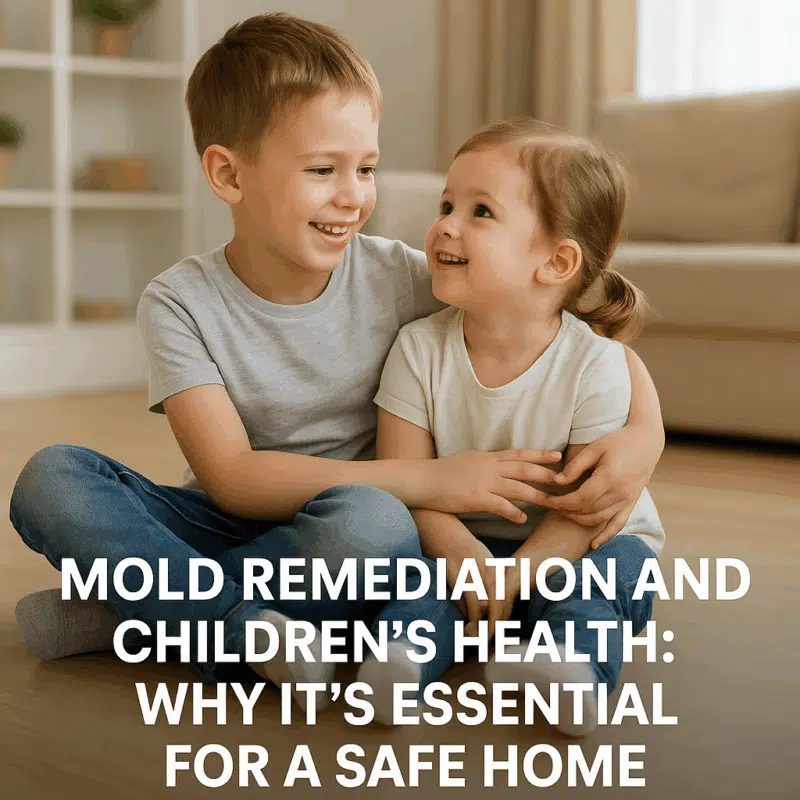Blog

La eliminación del moho y la salud de los niños: Por qué es esencial para un hogar seguro
Introduction: The Hidden Threat in Your Home
Imagine this: the comforting warmth of your family’s home, where laughter echoes through the halls, and every corner holds cherished memories. However, beneath this picture-perfect setting lies an unseen threat—mold. While often dismissed as a cosmetic nuisance, mold is a serious health hazard, especially for children.
Left untreated, mold can release spores into the air, compromising the very environment your kids rely on for growth, rest, and safety. Fortunately, understanding the importance of mold remediation gives you the power to protect your loved ones and restore peace of mind.
Why Mold Poses a Serious Risk to Children
Children are more vulnerable to mold exposure than adults because their bodies are still developing. Mold spores can trigger a range of health problems that affect their quality of life.
Mold and Respiratory Issues
Exposure to mold is strongly linked to coughing, wheezing, and even chronic respiratory illnesses in children. In households where kids already struggle with asthma, mold can worsen their condition dramatically.
Allergies and Immune System Sensitivity
Because children’s immune systems are still developing, mold exposure can lead to persistent allergic reactions like runny noses, itchy eyes, and skin rashes.
Developmental Concerns Linked to Mold Exposure
Some studies suggest prolonged mold exposure may contribute to learning difficulties, fatigue, and reduced concentration in children, affecting both their academic performance and overall well-being.
Common Places Mold Hides in Family Homes
Mold thrives in dark, damp, and humid spaces. Parents should be especially mindful of:
Damp Basements and Crawl Spaces – Common areas for hidden mold due to poor ventilation.
Bathrooms and Kitchens – Frequent moisture makes these rooms prime breeding grounds.
HVAC Systems and Air Ducts – Mold can spread through ventilation, affecting every room.
Warning Signs Parents Should Watch Out For
Visible Mold Growth and Musty Smells
Black or green patches on walls, ceilings, or furniture are telltale signs. Even if mold isn’t visible, a persistent musty odor is a red flag.
Unexplained Allergy or Asthma Symptoms in Kids
If your child’s symptoms improve when away from home but worsen indoors, mold may be the culprit.
Water Leaks and Stains
Past flooding, roof leaks, or pipe bursts create an environment ripe for mold growth.
The Mold Remediation Process Explained
Professional Mold Testing
The first step is identifying the extent of contamination through air and surface sampling.
Containment and Safe Removal
Professionals use protective barriers and HEPA filtration systems to safely remove mold without spreading spores.
Prevention and Moisture Control
Long-term success comes from addressing the root cause—fixing leaks, improving ventilation, and reducing humidity.
Health Benefits of Mold Remediation for Children
Improved Breathing and Allergy Relief
Parents often report fewer coughing fits, sneezing, and allergy flare-ups once mold is removed.
Better Sleep and Concentration
Clean air helps kids sleep better at night and stay more focused during the day.
A Safe and Nurturing Home Environment
Mold remediation restores your home as a true haven—where your children can grow, play, and thrive.
DIY vs. Professional Mold Remediation
The Risks of DIY Mold Removal
Scrubbing visible mold may temporarily improve appearances but rarely solves the root issue. Worse, improper removal can release more spores.
Why Professional Services are Safer for Families
Certified professionals use specialized tools, protective equipment, and scientific testing to ensure complete and safe remediation.
FAQs on Mold and Children’s Health
1. How quickly can mold affect a child’s health?
Symptoms may appear within days of exposure, especially in children with asthma or allergies.
2. Is mold more dangerous for infants than older children?
Yes. Infants are particularly vulnerable due to underdeveloped lungs and immune systems.
3. Can mold trigger asthma in kids?
Absolutely. Mold spores are a known asthma trigger and can make attacks more frequent.
4. What steps can parents take to prevent mold?
Maintain proper ventilation, fix leaks promptly, and use dehumidifiers in damp areas.
5. How often should families schedule mold inspections?
At least once a year, or immediately after water damage occurs.
Conclusion: Protecting Your Children, Protecting Your Home
Mold may be invisible at times, but its impact on your children’s health is real and potentially long-lasting. Taking swift action through professional mold remediation ensures your home remains the safe haven it’s meant to be.
Your children deserve to breathe fresh air, sleep peacefully, and grow in a healthy environment. By addressing mold head-on, you’re not just protecting your property—you’re safeguarding your family’s future.
📞 If you suspect mold in your home, call DASO Green Technologies today at 929-472-3899 for a free consultation and testing.

